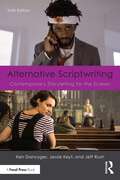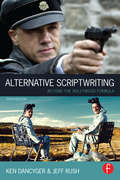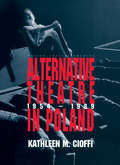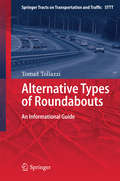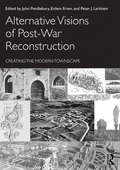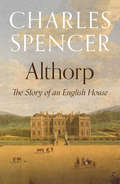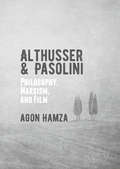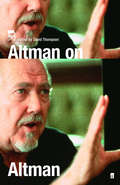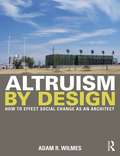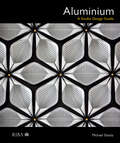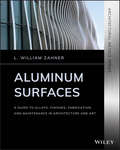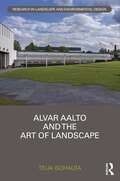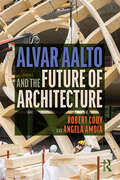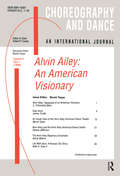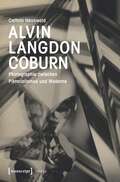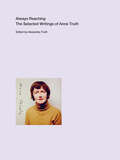- Table View
- List View
Alternative Scriptwriting: Contemporary Storytelling for the Screen
by Ken Dancyger Jessie Keyt Jeff RushThe three-act structure is so last century! Unlike other screenwriting books, this unique storytelling guide pushes you to break free of tired, formulaic writing by bending or breaking the rules of storytelling as we know them. This new edition dives into all the key aspects of scriptwriting, including structure, genre, character, form, and tone. Authors Ken Dancyger, Jessie Keyt, and Jeff Rush explore myriad alternatives to the traditional three-act story structure, going beyond teaching you "how to tell a story" by teaching you how to write against conventional formulas to produce original, exciting material. Fully revised and updated, the book includes new examples from contemporary and classic cinema and episodic series, as well as additional content on strategies for plot, character, and genre; an exploration of theatrical devices in film; and approaches to scriptwriting with case studies of prolific storytellers such as Billy Wilder, Kelly Reichardt, Phoebe Waller-Bridge, and Kathryn Bigelow. Ideal for students of screenwriting and professional screenwriters wishing to develop their craft and write original scripts.
Alternative Scriptwriting: Beyond the Hollywood Formula (Scriptwriting Ser.)
by Ken Dancyger Jeff RushLearn the rules of scriptwriting, and then how to successfully break them.Unlike other screenwriting books, this unique guide pushes you to challenge yourself and break free of tired, formulaic writing--bending or breaking the rules of storytelling as we know them. Like the best-selling previous editions, seasoned authors Dancyger and Rush explore alternative approaches to the traditional three-act story structure, going beyond teaching you "how to tell a story" by teaching you how to write against conventional formulas to produce original, exciting material. The pages are filled with an international range of contemporary and classic cinema examples to inspire and instruct. New to this edition. New chapter on the newly popular genres of feature documentary, long-form television serials, non-linear stories, satire, fable, and docudrama. New chapter on multiple-threaded long form, serial television scripts. New chapter on genre and a new chapter on how genre’s very form is flexible to a narrative. New chapter on character development. New case studies, including an in-depth case study of the dark side of the fable, focusing on The Wizard of Oz and Pan’s Labyrinth.
Alternative Scriptwriting: Beyond the Hollywood Formula
by Ken Dancyger Jeff RushLearn the rules of scriptwriting, and then how to successfully break them.Unlike other screenwriting books, this unique guide pushes you to challenge yourself and break free of tired, formulaic writing--bending or breaking the rules of storytelling as we know them. Like the best-selling previous editions, seasoned authors Dancyger and Rush explore alternative approaches to the traditional three-act story structure, going beyond teaching you "how to tell a story" by teaching you how to write against conventional formulas to produce original, exciting material. The pages are filled with an international range of contemporary and classic cinema examples to inspire and instruct. New to this edition. New chapter on the newly popular genres of feature documentary, long-form television serials, non-linear stories, satire, fable, and docudrama. New chapter on multiple-threaded long form, serial television scripts. New chapter on genre and a new chapter on how genre’s very form is flexible to a narrative. New chapter on character development. New case studies, including an in-depth case study of the dark side of the fable, focusing on The Wizard of Oz and Pan’s Labyrinth.
Alternative Theatre in Poland
by Kathleen CioffiThe complex nature of the relationship between theatre and politics is explored in this study of the Polish theatre scene. It traces the development of the alternative theatre movement from its origins, in the 1950s, through to its decline in the late 1980s.
Alternative Theatre in Poland
by Kathleen CioffiThe complex nature of the relationship between theatre and politics is explored in this study of the Polish theatre scene. It traces the development of the alternative theatre movement from its origins, in the 1950s, through to its decline in the late 1980s.
Alternative Types of Roundabouts: An Informational Guide (Springer Tracts on Transportation and Traffic #6)
by Tomaž TollazziThis book presents a history of roundabouts, an introduction to their design, calculations of their capacity and traffic-safety features. It describes the key features of standard roundabouts and their limitations. Alternative types of roundabouts are a fairly recent development and have only been implemented in a few countries to date. The book illustrates a broad variety of these recent alternative types of roundabouts, as well as proposed types still in the development phase, explaining for each the specific needs it meets, its advantages and drawbacks. In closing, the book offers an outlook on the role of roundabouts in future street traffic.
Alternative Visions of Post-War Reconstruction: Creating the modern townscape
by John Pendlebury Erdem Erten Larkham J PeterThe history of post Second World War reconstruction has recently become an important field of research around the world; Alternative Visions of Post-War Reconstruction is a provocative work that questions the orthodoxies of twentieth century design history. This book provides a key critical statement on mid-twentieth century urban design and city planning, focused principally upon the period between the start of the Second World War to the mid-sixties. The various figures and currents covered here represent a largely overlooked field within the history of 20th century urbanism. In this period while certain modernist practices assumed an institutional role for post-war reconstruction and flourished into the mainstream, such practices also faced opposition and criticism leading to the production of alternative visions and strategies. Spanning from a historically-informed modernism to the increasing presence of urban conservation the contributors examine these alternative approaches to the city and its architecture.
Alternative Visions of Post-War Reconstruction: Creating the modern townscape
by John Pendlebury Erdem Erten Larkham J PeterThe history of post Second World War reconstruction has recently become an important field of research around the world; Alternative Visions of Post-War Reconstruction is a provocative work that questions the orthodoxies of twentieth century design history. This book provides a key critical statement on mid-twentieth century urban design and city planning, focused principally upon the period between the start of the Second World War to the mid-sixties. The various figures and currents covered here represent a largely overlooked field within the history of 20th century urbanism. In this period while certain modernist practices assumed an institutional role for post-war reconstruction and flourished into the mainstream, such practices also faced opposition and criticism leading to the production of alternative visions and strategies. Spanning from a historically-informed modernism to the increasing presence of urban conservation the contributors examine these alternative approaches to the city and its architecture.
Althorp: The Story Of An English House
by Charles SpencerThe definitive history of one of England’s greatest houses: Althorp, where for five hundred years the Spencer family have made their home.
Althusser and Pasolini: Philosophy, Marxism, and Film
by Agon HamzaAgon Hamza offers an in-depth analysis of the main thesis of Louis Althusser’s philosophical enterprise alongside a clear, engaging dissection of Pier Paolo Pasolini’s most important films. There is a philosophical, religious, and political relationship between Althusser’s philosophy and Pier Paolo Pasolini’s films. Hamza teases out the points of contact, placing specific focus on critiques of ideology, religion, ideological state apparatuses, and the class struggle. The discussion, however, does not address Althusser and Pasolini alone. Hamza also draws on Spinoza, Hegel, Marx, and Žižek to complete his study. Pasolini’s films are a treasure-trove of Althusserian thought, and Hamza ably employs Althusserian terms in his reading of the films. Althusser and Pasolini provides a creative reconstruction of Althusserian philosophy, as well as a novel examination of Pasolini’s film from the perspective of the filmmaker’s own thought and Althusser’s theses.
Altman on Altman
by David ThompsonIn Altman on Altman, one of American cinema's most incorrigible mavericks reflects on a brilliant career.Robert Altman served a long apprenticeship in movie-making before his great breakthrough, the Korean War comedy M*A*S*H (1969). It became a huge hit and won the Palme d'Or at Cannes, but also established Altman's inimitable use of sound and image, and his gift for handling a repertory company of actors. The 1970s then became Altman's decade, with a string of masterpieces: McCabe and Mrs Miller, The Long Goodbye,Thieves Like Us, Nashville . . . In the 1980s Altman struggled to fund his work, but he was restored to prominence in 1992 with The Player, an acerbic take on Hollywood. Short Cuts, an inspired adaptation of Raymond Carver, and the Oscar-winning Gosford Park, underscored his comeback.Now he recalls the highs and lows of his career trajectory to David Thompson in this definitive interview book, part of Faber's widely acclaimed Directors on Directors series. 'Hearing in his own words in Altman on Altman just how much of his films occur spontaneously, as a result of last-minute decisions on set, is fascinating . . . For film lovers, this is just about indispensable.' Ben Sloan,Metro London
Altruism by Design: How To Effect Social Change as an Architect
by Adam R. WilmesAltruism by Design: How to Effect Social Change as an Architect is meant to prepare the individual designer – whether a student or practicing professional – for a career dedicated to serving communities in need through design and construction. It will help you understand the complexities, opportunities, and benefits of creating architecture that promotes social equality and community so that you can make a difference. What you'll learn: -How community-based studios can respond to natural disasters and economic conditions-How to build what you design-How to develop relationships with non-traditional clients-How to structure your career to be dedicated to social change and sustainable design-How to discover funding opportunities for projects in a not-for-profit firm-How to consider moral and financial aspects of your practice-How you can collaborate with other design professions to determine the future of the built environment Featuring detailed case studies, including work by Studio 804 and Pyotak Architects, and more than 100 color images; this book is essential reading for providing you with a viable path to altruistic design.
Altruism by Design: How To Effect Social Change as an Architect
by Adam R. WilmesAltruism by Design: How to Effect Social Change as an Architect is meant to prepare the individual designer – whether a student or practicing professional – for a career dedicated to serving communities in need through design and construction. It will help you understand the complexities, opportunities, and benefits of creating architecture that promotes social equality and community so that you can make a difference. What you'll learn: -How community-based studios can respond to natural disasters and economic conditions-How to build what you design-How to develop relationships with non-traditional clients-How to structure your career to be dedicated to social change and sustainable design-How to discover funding opportunities for projects in a not-for-profit firm-How to consider moral and financial aspects of your practice-How you can collaborate with other design professions to determine the future of the built environment Featuring detailed case studies, including work by Studio 804 and Pyotak Architects, and more than 100 color images; this book is essential reading for providing you with a viable path to altruistic design.
Aluminium: A Studio Design Guide
by Michael StaceyAre you making the most of aluminium? Aluminium is one of the most flexible and durable materials to design with. With exceptional strength, durability and affordability, it provides us with more than simply the ability to select products. When understood properly, aluminium becomes something to design with. In a world where over half humankind now lives in cities there is a need to design zero carbon, attractive and durable architecture. This can only be achieved if we are more resourceful, if we achieve more with less by understanding materials well, using finite element analysis and computer aided design. Aluminium can be part of that route to affordable and durable architecture. Recycling aluminium takes only 5% of the energy required to produce primary aluminium and it can be recycled almost infinitely without any loss of properties. Combining an inspirational overview of the use of aluminium in architecture and infrastructure with a technical level of detail, this book shows how useful and versatile aluminium is – and how architects can actually design with it. This book provides access to state of the art research into the best practice in application of aluminium to architecture: from curtain walling and cladding roofing to structural considerations. It demonstrates the material’s design flexibility and how it works well with other materials. Each process will be accompanied by exemplar case studies that demonstrate the potential and application. Woven into the structure of the book are the primary benefits of aluminium: its flexiblilty, its durability, its sustainable properties and its cost-effectiveness. Whether you’re a first year student or a seasoned designer or engineer, this book provides an accessible and deep dive into the uses and benefits of aluminium.
Aluminium: A Studio Design Guide
by Michael StaceyAre you making the most of aluminium? Aluminium is one of the most flexible and durable materials to design with. With exceptional strength, durability and affordability, it provides us with more than simply the ability to select products. When understood properly, aluminium becomes something to design with. In a world where over half humankind now lives in cities there is a need to design zero carbon, attractive and durable architecture. This can only be achieved if we are more resourceful, if we achieve more with less by understanding materials well, using finite element analysis and computer aided design. Aluminium can be part of that route to affordable and durable architecture. Recycling aluminium takes only 5% of the energy required to produce primary aluminium and it can be recycled almost infinitely without any loss of properties. Combining an inspirational overview of the use of aluminium in architecture and infrastructure with a technical level of detail, this book shows how useful and versatile aluminium is – and how architects can actually design with it. This book provides access to state of the art research into the best practice in application of aluminium to architecture: from curtain walling and cladding roofing to structural considerations. It demonstrates the material’s design flexibility and how it works well with other materials. Each process will be accompanied by exemplar case studies that demonstrate the potential and application. Woven into the structure of the book are the primary benefits of aluminium: its flexiblilty, its durability, its sustainable properties and its cost-effectiveness. Whether you’re a first year student or a seasoned designer or engineer, this book provides an accessible and deep dive into the uses and benefits of aluminium.
Aluminum Surfaces: A Guide to Alloys, Finishes, Fabrication and Maintenance in Architecture and Art (Architectural Metals Series)
by L. William ZahnerA full-color guide for architects and design professionals to the selection and application of aluminum Aluminum Surfaces, second in William Zahner's Architectural Metals Series, provides a comprehensive and authoritative treatment of aluminum applications in architecture and art. It offers architecture and design professionals the information they need to ensure proper maintenance and fabrication techniques through detailed information and full color images. It covers everything from the history of the metal and choosing the right alloy, to detailed information on a variety of surface and chemical finishes and corrosion resistance. The book also features case studies offering architecture and design professionals strategies for designing and executing successful projects using aluminum. Aluminum Surfaces is filled with illustrative case studies that offer strategies for designing and executing successful projects using aluminum. All the books in Zahner’s Architectural Metals Series offer in-depth coverage of today’s most commonly used metals in architecture and art. This important book: Contains a comprehensive guide to the use and maintenance of aluminum surfaces in architecture and art Features full-color images of a variety of aluminum finishes, colors, textures, and forms Includes case studies with performance data that feature strategies on how to design and execute successful projects using aluminum Offers methods to address corrosion, before and after it occurs Discusses the environmental impact of aluminum from the creation process through application Explains the significance of the different alloys and the forms available to the designer Discusses expectations when using aluminum in various exposures For architecture professionals, metal fabricators, developers, architecture students and instructors, designers, and artists working with metals, Aluminum Surfaces offers a logical framework for the selection and application of aluminum in all aspects of architecture.
Aluminum Surfaces: A Guide to Alloys, Finishes, Fabrication and Maintenance in Architecture and Art (Architectural Metals Series)
by L. William ZahnerA full-color guide for architects and design professionals to the selection and application of aluminum Aluminum Surfaces, second in William Zahner's Architectural Metals Series, provides a comprehensive and authoritative treatment of aluminum applications in architecture and art. It offers architecture and design professionals the information they need to ensure proper maintenance and fabrication techniques through detailed information and full color images. It covers everything from the history of the metal and choosing the right alloy, to detailed information on a variety of surface and chemical finishes and corrosion resistance. The book also features case studies offering architecture and design professionals strategies for designing and executing successful projects using aluminum. Aluminum Surfaces is filled with illustrative case studies that offer strategies for designing and executing successful projects using aluminum. All the books in Zahner’s Architectural Metals Series offer in-depth coverage of today’s most commonly used metals in architecture and art. This important book: Contains a comprehensive guide to the use and maintenance of aluminum surfaces in architecture and art Features full-color images of a variety of aluminum finishes, colors, textures, and forms Includes case studies with performance data that feature strategies on how to design and execute successful projects using aluminum Offers methods to address corrosion, before and after it occurs Discusses the environmental impact of aluminum from the creation process through application Explains the significance of the different alloys and the forms available to the designer Discusses expectations when using aluminum in various exposures For architecture professionals, metal fabricators, developers, architecture students and instructors, designers, and artists working with metals, Aluminum Surfaces offers a logical framework for the selection and application of aluminum in all aspects of architecture.
Alvar Aalto and The Art of Landscape (Routledge Research in Landscape and Environmental Design)
by Teija IsohautaAlvar Aalto and The Art of Landscape captures the essence of the Finnish architect’s landscape concept, emphasising culture and tradition, which characterised his approach to and understanding of architecture as part of the wider environment. From the forests of his youth to sights from his travels, Alvar Aalto (1898–1976) was influenced by outdoor landscapes. Throughout his career, he felt the need to shape the terrain and this became a signature of his architecture. Divided into five chapters, this book traces Aalto’s relationship with landscape, starting with an analysis of his definitions and descriptions of landscape language, which ranged from natural references and biological terms, to synonyms and comparisons. It includes beautifully illustrated case study projects from the 1950s and 1960s, discussing Aalto’s transformation of different landscapes through topography, terracing and tiers, ruins and natural elements, horizon outlines, landmarks, and the repetition of form. Featuring archival sketches, garden drawings, and plans, the book also contains Aalto’s text ‘Architecture in the Landscape of Central Finland’ from 1925 in the appendix. This book provides fascinating, untold insights into Aalto’s relationship with landscape and how this developed during his lifetime, for scholars, researchers, and students interested in architecture and landscape history, landscape art, and cultural studies.
Alvar Aalto and The Art of Landscape (Routledge Research in Landscape and Environmental Design)
by Teija IsohautaAlvar Aalto and The Art of Landscape captures the essence of the Finnish architect’s landscape concept, emphasising culture and tradition, which characterised his approach to and understanding of architecture as part of the wider environment. From the forests of his youth to sights from his travels, Alvar Aalto (1898–1976) was influenced by outdoor landscapes. Throughout his career, he felt the need to shape the terrain and this became a signature of his architecture. Divided into five chapters, this book traces Aalto’s relationship with landscape, starting with an analysis of his definitions and descriptions of landscape language, which ranged from natural references and biological terms, to synonyms and comparisons. It includes beautifully illustrated case study projects from the 1950s and 1960s, discussing Aalto’s transformation of different landscapes through topography, terracing and tiers, ruins and natural elements, horizon outlines, landmarks, and the repetition of form. Featuring archival sketches, garden drawings, and plans, the book also contains Aalto’s text ‘Architecture in the Landscape of Central Finland’ from 1925 in the appendix. This book provides fascinating, untold insights into Aalto’s relationship with landscape and how this developed during his lifetime, for scholars, researchers, and students interested in architecture and landscape history, landscape art, and cultural studies.
Alvar Aalto and the Future of Architecture
by Robert Cody Angela AmoiaIn the contemporary practice of architecture, digital design and fabrication are emergent technologies in transforming how architects present a design and form a material strategy that is responsible, equitable, sustainable, resilient, and forward-looking. This book exposes dialogue between history, theory, design, construction, technology, and sensory experience by means of digital simulations that enhance the assessment and values of our material choices. It offers a critical look to the past to inspire the future. This new edition looks to Alvar Aalto as the primary protagonist for channeling discussions related to these topics. Architects like ALA, Shigeru Ban, 3XN, Peter Zumthor, and others also play the role of contemporary guides in this review. The work of Aalto and selected contemporary architects, along with computer modeling software, showcase the importance of comprehensive design. Organized by the five Ts of contemporary architectural discourse—Typology, Topology, Tectonics, Technic, Thermodynamics—each chapter is used to connect history through Aalto and develop conversations concerning historical and contemporary models, digital simulations, ecological and passive/active material concerns, construction and fabrications, and healthy sensorial environments. Written for students and academics, this book bridges knowledge from academia into practice and vice versa to help architects become better stewards of the environment, make healthier and more accountable buildings, and find ways to introduce policy to make technology a critical component in thinking about and making architecture.
Alvar Aalto and the Future of Architecture
by Robert Cody Angela AmoiaIn the contemporary practice of architecture, digital design and fabrication are emergent technologies in transforming how architects present a design and form a material strategy that is responsible, equitable, sustainable, resilient, and forward-looking. This book exposes dialogue between history, theory, design, construction, technology, and sensory experience by means of digital simulations that enhance the assessment and values of our material choices. It offers a critical look to the past to inspire the future. This new edition looks to Alvar Aalto as the primary protagonist for channeling discussions related to these topics. Architects like ALA, Shigeru Ban, 3XN, Peter Zumthor, and others also play the role of contemporary guides in this review. The work of Aalto and selected contemporary architects, along with computer modeling software, showcase the importance of comprehensive design. Organized by the five Ts of contemporary architectural discourse—Typology, Topology, Tectonics, Technic, Thermodynamics—each chapter is used to connect history through Aalto and develop conversations concerning historical and contemporary models, digital simulations, ecological and passive/active material concerns, construction and fabrications, and healthy sensorial environments. Written for students and academics, this book bridges knowledge from academia into practice and vice versa to help architects become better stewards of the environment, make healthier and more accountable buildings, and find ways to introduce policy to make technology a critical component in thinking about and making architecture.
Alvin Ailey: An American Visionary (Choreography and Dance Studies Series)
by Muriel TopazDuring its three and half decades, the Alvin Ailey Company has left lasting markers on the playing field of American Modern Dance. It has established a reputation for precise but spectacular dancing, for depicting an African American ethos with sensitivity and elegance, and set standards for performance excellence. Ailey's choreography caused shock waves in the dance world of 1958 and continues to move audiences deeply. The company has also provided a paradigm for a modern dance repertory company. Contributors include Jennifer Dunning, Ronni Favors, Allan Gray, Denise Jefferson, Cynthia Sithembile West, Muriel Topaz, James Truitte, and Sylvia Waters. Eulogies written by David Dinkins, Carmen de Lavallade, Judith Jamison and Maya Angelou.
Alvin Ailey: An American Visionary (Choreography and Dance Studies Series #4.1)
by Muriel TopazDuring its three and half decades, the Alvin Ailey Company has left lasting markers on the playing field of American Modern Dance. It has established a reputation for precise but spectacular dancing, for depicting an African American ethos with sensitivity and elegance, and set standards for performance excellence. Ailey's choreography caused shock waves in the dance world of 1958 and continues to move audiences deeply. The company has also provided a paradigm for a modern dance repertory company. Contributors include Jennifer Dunning, Ronni Favors, Allan Gray, Denise Jefferson, Cynthia Sithembile West, Muriel Topaz, James Truitte, and Sylvia Waters. Eulogies written by David Dinkins, Carmen de Lavallade, Judith Jamison and Maya Angelou.
Alvin Langdon Coburn: Photographie zwischen Piktorialismus und Moderne (Image #128)
by Cathrin HauswaldAlvin Langdon Coburn ist der erste Künstler, der 1916 von »abstrakter Photographie« schreibt und sie auch ästhetisch umsetzt. Und das, obwohl er selbst der piktorialistischen Strömung, der stimmungsvollen Kunstphotographie, angehört. Anhand von Coburns Wirken als zentrale Figur des epistemisch-ästhetischen Umbruchs in der Zeit der Jahrhundertwende verdeutlicht Cathrin Hauswald eindrucksvoll die Entwicklung der Photographie vom 19. Jahrhundert in die Moderne. Sie zeigt: Während Coburn die Beben des technologischen und photographischen Fortschritts aufzeichnet und gleichsam gestaltet, inszeniert sich der Kunstphotograph selbst als ambivalentes und geradezu antimodernes Element seines photographischen Schaffens, dessen Ziel stets die eigene Nobilitierung bleibt.
Always Reaching: The Selected Writings of Anne Truitt
by Anne TruittAn expansive collection of texts providing insight into the inner life, creativity, and practice of the innovative American artist Anne Truitt Spanning more than fifty years, this comprehensive volume collects the letters, journal entries, interviews, lectures, reviews, and remembrances of the groundbreaking twentieth-century artist Anne Truitt (1921–2004). Alexandra Truitt, the artist’s daughter and a leading expert on her work, has carefully selected these writings, most of which are previously unpublished, from the artist’s papers at Bryn Mawr College as well as private holdings. Revelations about the artist’s life abound. Among Truitt’s earliest writings are excerpts from journals written more than a decade before her first artistic breakthrough, in which she establishes themes that would occupy her for decades. In later texts she shares uncommon insights into the practices of other artists and writers, both predecessors and peers. Like Truitt’s published journals, these writings offer a compelling narrative of her development as an artist and efforts to find her voice as a writer. They show that Truitt’s creative impulse to translate the inner workings of her mind into a symbolic language, so important to understanding her sculpture, predates her art.
